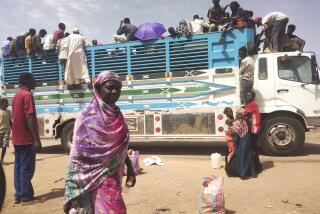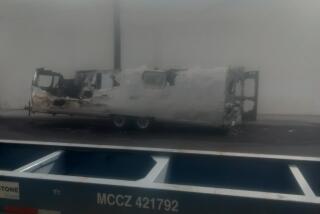Nepal quake aid effort gains U.S. troops, aircraft; more people rescued
A U.S. military contingent arrived just before sunset Sunday, more than a week after a magnitude 7.8 earthquake, bringing massive cargo planes and a team of four Osprey helicopters to join the international aid effort at Nepal’s international airport.
The planes were allowed to land despite a temporary ban on large aircraft instituted on Friday after the influx of flights carrying aid began to take a toll on the airport’s single runway, an airport spokesman said. The U.S. planes complied with new weight restrictions.
China and India have already flown in aircraft and other aid. Scores of countries, including the United States, have sent search-and-rescue teams, which remarkably continue to find survivors in the rubble.
Several people were reported rescued on Sunday.
The U.S. military response to the earthquake was delayed because of vetting and was designed to be minimal, officials said.
“We want to stay as small as possible here,” said Marine Brig. Gen. Paul Kennedy, who greeted the pilots.
By Monday, the military will have delivered three Huey and 10 Osprey helicopters and a team of 65 U.S. service members that’s expected to grow to as many as 400, Kennedy said. The operation, which Kennedy said will last at least a month, is expected to cost at least $10 million.
“Why are we doing it?” said U.S. Ambassador to Nepal Peter W. Bodde, who welcomed the first pilot after he touched down. “Because they’ve always been a good friend. We’ve had development programs here for 60 years. We’re the United States of America, and it’s the right thing to do.”
Nepal’s capital was still rattled by aftershocks. So far, officials say, the quake has killed more than 7,250 people and injured 14,267. Authorities have said they expect the death toll to increase as they reach remote areas and dig through rubble.
The U.S. helicopters will help, arriving airmen said Sunday.
“Our aircraft are ideal for this situation,” said Marine Lt. Col. Edward Powers, 40, who trained at Camp Pendleton, is stationed in Okinawa, Japan, and arrived Sunday from exercises in the Philippines.
The Huey helicopters his squadron flies have “high visibility,” he said, and fit in small spaces.
But they don’t fly well above 12,000 feet, he said, and because some of the hardest-hit areas are high in the mountains, that could pose a problem.
The helicopters will fly from Tribhuvan International Airport in Katmandu and an airport near the Indian border, Kennedy said. He said airmen later will probably create smaller landing zones closer to the hardest-hit areas.
The first Huey flight was expected to take off late Sunday with a search-and-rescue team from the U.S. Agency for International Development and do a flyover of Rasuwa, 75 miles north of the capital in the Himalaya region. But the flight was delayed, a U.S. Embassy spokesman said Monday.
“We’ll look and see what the damage is and if there is anything we can respond to,” Bill Berger, the USAID disaster assistance response team leader, said Sunday at the airport.
With him on the tarmac were members of two U.S. search-and-rescue teams he’s overseeing here from Los Angeles County and Fairfax County, Va.
Los Angeles County Fire Capt. Andrew Olvera beamed as he watched the helicopters arrive.
“It’s going to help us see what other efforts can be done in those hard-to-reach areas,” said Olvera, whose team helped pull a 15-year-old boy from the rubble Thursday.
Birendra Prasad Shrestha, manager of the airport, said planes weighing more than 196 tons were temporarily barred from landing because they were damaging the concrete runway.
“So far 13 such aircraft haven’t been given landing permission. This is to avoid congestion at the airport and also avoid any damage to the runway,” Shrestha said.
More rescue attempts were underway Sunday, officials said.
“As we speak, we have a helicopter up in an area where we heard there might be missing Americans, in the Langtang area,” the ambassador said, referring to a popular trekking area about 40 miles north of the capital, where the quake triggered an avalanche.
U.S. forces will also bring forklifts to more quickly unload and route aid shipments.
The United Nations has asked the Nepalese government to relax customs controls it says have delayed relief shipments. Nepalese army officials at the airport said that they have already improved plane manifest screening at customs and suspended fees, but that minimum screening is necessary, especially to prevent fraud.
Aid deliveries have been delayed in part because of the limited capacity of the airport, said a Nepalese army official who works in the aviation unit and asked not to be named because he was not authorized to speak to reporters. The airport has nine bays, he said, and only six or seven can fit larger aircraft such as 747s.
Search-and-rescue teams from around the world remained camped out near the airport. Nepalese officials said there was less for the teams to do as the disaster response shifts from rescue to recovery and relief.
“We’re always hoping against hope,” Berger said.
On Sunday, there were several seemingly miraculous rescues, including three people found beneath the rubble in northeastern Nepal.
They were about 22 miles east of the capital near Chautara, an Icelandic Red Cross official said.
Chautara is the seat of a district where more than 2,000 people died in the earthquake, the highest death toll of the country’s 75 districts. The town is in ruins, a maze of toppled concrete, twisted steel and crushed vehicles.
Many families have been sleeping in a field under tents provided by local groups and the Red Cross. Volunteers have been cooking rice and lentils for scores of displaced residents and for those whose food stocks are dwindling.
“There hasn’t been much outside help,” said Porum Bahadur Shreshta, a shopkeeper who pointed to his nearly empty sacks of grain and lentils. Landslides had closed part of the highway to the capital, slowing supplies. Also, he said, “there are fears of looting, so trucks haven’t been arriving.”
In surrounding villages, officials say, scores of residents are still unaccounted for. Electricity has been cut off to the area, making it difficult to find the missing.
“We still don’t know how many people are unaccounted for,” Sindhupalchowk District Chief Krishna Prasad Gyawali said.
Hennessy-Fiske reported from Katmandu and Bengali from Sindhupalchowk.
Twitter: @mollyhf
Twitter: @SBengali
More to Read
Start your day right
Sign up for Essential California for news, features and recommendations from the L.A. Times and beyond in your inbox six days a week.
You may occasionally receive promotional content from the Los Angeles Times.








